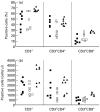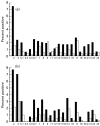T cell receptor repertoire and function in patients with DiGeorge syndrome and velocardiofacial syndrome
- PMID: 10886249
- PMCID: PMC1905679
- DOI: 10.1046/j.1365-2249.2000.01247.x
T cell receptor repertoire and function in patients with DiGeorge syndrome and velocardiofacial syndrome
Abstract
DiGeorge syndrome (DGS) and velocardiofacial syndrome (VCFS) are associated with chromosome 22q11.2 deletion. Limited information is available on the T cell receptor (TCR) Vbeta repertoire. We therefore investigated TCR Vbeta families in lymphocytes isolated from blood and thymic samples of seven patients with DGS and seven patients with VCFS, all with 22q11.2 deletion. We also studied activities related to TCR signalling including in vitro proliferation, anti-CD3-induced protein tyrosine phosphorylation, and susceptibility to apoptosis. Reduced CD3+ T cells were observed in most patients. Spontaneous improvement of T cell numbers was detected in patients, 3 years after the first study. Analysis of CD4+ and CD8+ TCR Vbeta repertoire in peripheral and thymic cells showed a normal distribution of populations even if occasional deletions were observed. Lymphoproliferative responses to mitogens were comparable to controls as well as anti-CD3-induced protein tyrosine phosphorylation. Increased anti-CD3-mediated apoptosis was observed in thymic cells. Our data support the idea that in patients surviving the correction of cardiac anomalies, the immune defect appears milder than originally thought, suggesting development of a normal repertoire of mature T cells.
Figures


Similar articles
-
Biased T-cell receptor repertoires in patients with chromosome 22q11.2 deletion syndrome (DiGeorge syndrome/velocardiofacial syndrome).Clin Exp Immunol. 2003 May;132(2):323-31. doi: 10.1046/j.1365-2249.2003.02134.x. Clin Exp Immunol. 2003. PMID: 12699424 Free PMC article.
-
Flow cytometric analysis of TCR Vβ repertoire in patients with 22q11.2 deletion syndrome.Scand J Immunol. 2011 Jun;73(6):577-85. doi: 10.1111/j.1365-3083.2011.02527.x. Scand J Immunol. 2011. PMID: 21323691
-
Post-natal ontogenesis of the T-cell receptor CD4 and CD8 Vbeta repertoire and immune function in children with DiGeorge syndrome.J Clin Immunol. 2005 May;25(3):265-74. doi: 10.1007/s10875-005-4085-3. J Clin Immunol. 2005. PMID: 15981092
-
Transplantation of thymus tissue in complete DiGeorge syndrome.N Engl J Med. 1999 Oct 14;341(16):1180-9. doi: 10.1056/NEJM199910143411603. N Engl J Med. 1999. PMID: 10523153 Clinical Trial.
-
Role of the vascular endothelial growth factor isoforms in retinal angiogenesis and DiGeorge syndrome.Verh K Acad Geneeskd Belg. 2005;67(4):229-76. Verh K Acad Geneeskd Belg. 2005. PMID: 16334858 Review.
Cited by
-
Primary immunodeficiency diagnosed at autopsy: a case report.BMC Res Notes. 2014 Jul 4;7:425. doi: 10.1186/1756-0500-7-425. BMC Res Notes. 2014. PMID: 24996427 Free PMC article.
-
COVID-19 Severity, Cardiological Outcome, and Immunogenicity of mRNA Vaccine on Adult Patients With 22q11.2 DS.J Allergy Clin Immunol Pract. 2023 Jan;11(1):292-305.e2. doi: 10.1016/j.jaip.2022.10.010. Epub 2022 Oct 21. J Allergy Clin Immunol Pract. 2023. PMID: 36280136 Free PMC article.
-
Association of juvenile idiopathic arthritis and digeorge syndrome; a case report.Iran J Pediatr. 2014 Jun;24(3):334-6. Iran J Pediatr. 2014. PMID: 25562032 Free PMC article. No abstract available.
-
Clinical Practice Guidelines for the Immunological Management of Chromosome 22q11.2 Deletion Syndrome and Other Defects in Thymic Development.J Clin Immunol. 2023 Feb;43(2):247-270. doi: 10.1007/s10875-022-01418-y. Epub 2023 Jan 17. J Clin Immunol. 2023. PMID: 36648576 Free PMC article. Review.
-
Biased T-cell receptor repertoires in patients with chromosome 22q11.2 deletion syndrome (DiGeorge syndrome/velocardiofacial syndrome).Clin Exp Immunol. 2003 May;132(2):323-31. doi: 10.1046/j.1365-2249.2003.02134.x. Clin Exp Immunol. 2003. PMID: 12699424 Free PMC article.
References
-
- DiGeorge A. Congenital absence of the thymus and its immunologic consequences: concurrence with congenital hypoparathyroidism. In: Good RA, Bergsma D, editors. Immunologic deficiency diseases in man, Birth Defects Original Article Series. Vol. 4. New York: New York National Foundation Press; 1968. pp. 116–21.
-
- Hong R. The DiGeorge anomaly. Immunodef Rev. 1991;3:1–14. - PubMed
-
- Pizzuti A, Novelli G, Ratti A, et al. UFD1L, a developmentally expressed ubiquitination gene, is deleted in CATCH 22 syndrome. Hum Mol Genet. 1997;6:259–65. - PubMed
Publication types
MeSH terms
Substances
LinkOut - more resources
Full Text Sources
Research Materials

